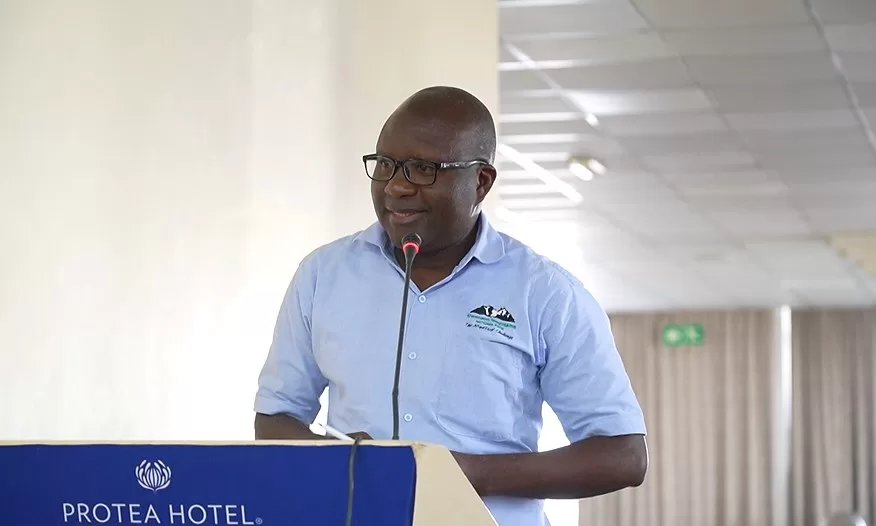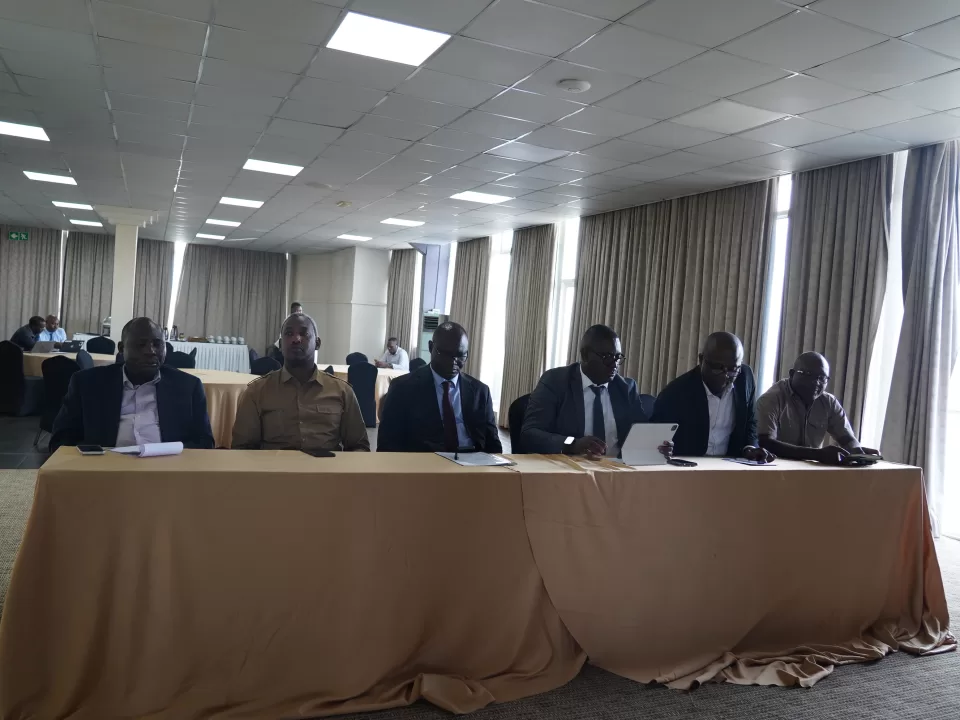Commitment of stakeholders reaffirmed, as they validate the 2024-2033 Greater Virunga Transboundary Strategic Plan
The Greater Virunga Landscape Transboundary Strategic Plan 2024-2033 validation meeting has started today at Skyz Hotel Naguru in Kampala, Republic of Uganda on the 20th of March 2024.
Various stakeholders, including representatives of the conservation institutions from the 3 GVTC partner states, namely DRC, Rwanda, and Uganda; international and national Conservation non-governmental organizations; academia, tourism-related private sector, media, and the development partners were gathered at Skyz Hotel to validate the 10 years Greater Virunga Landscape Transboundary Strategic plan 2024-2033.
The purpose of the validation meeting was to review the strategic plan and provide high-level decision-making on the strategic direction and priorities over the next ten years 2024-2033 to ensure tie-lose ends, buy-in and, ownership.

Group photo after the opening of the GVL TSP validation meeting
This 10-year Greater Virunga Landscape Transboundary Strategic Plan 2024-2033 has four pillars:
- Strengthen transboundary collaboration and coordination for effective natural resource management in the Greater Virunga Landscape.
- Strengthen advocacy and community empowerment to improve participation in the effective management of the Greater Virunga Landscape.
- Support the development and implementation of innovative finance and investments for effective conservation of Greater Virunga Landscape.
- Improve governance and effective management of transboundary natural resources in the Greater Virunga Landscape.
Talking about the rationale behind this strategy, the rationale is multifaceted, driven by the urgent need to address converging threats and capitalise on the following emerging opportunities:
- The urgency of Action: The Greater Virunga Landscape faces numerous interconnected challenges and without immediate and unified action, the future of this irreplaceable natural treasure hangs in the balance.
- Need for a Transboundary Approach: The Greater Virunga Landscape transcends national borders. This Plan recognises the interconnectedness of the landscape and prioritises a collaborative, transboundary approach for sustainable management.
- Harnessing Opportunity: Despite the challenges, the Greater Virunga Landscape holds immense potential. The Plan seeks to tap into this potential by promoting sustainable development initiatives that empower communities and incentivise conservation.
- Building on Progress: The latest TSP does not reinvent the wheel, the plan strives to chart a more effective and inclusive path for the future of the GVL.
Dr. Andrew G. Seguya, GVTC Executive Secretary highlighted that there is a lot to celebrate, like the strengthened collaboration of players, such as state actors, non-state actors, non-governmental organizations, private sectors and communities, improved livelihoods, wildlife conservation in this GVL region, etc.

Dr. Andrew G. Seguya, delivering his opening remarks during the GVL TSP validation meeting
« However, one can’t say we have reached where we wanted to go. Challenges related to insecurity in the region, population density causing pressure on protected areas’ natural resources, poverty in the communities around the protected areas, human-wildlife conflicts and climate change impacts are still felt.” Said Dr. Andrew G. Seguya, Executive Secretary of GVTC.
The significance of the Greater Virunga Landscape transcends its geographical boundaries as recognized by UNESCO thanks to its biological diversity richness. This landscape offers invaluable ecological, economic, and social benefits despite challenges related to armed conflicts, poverty, population growth, and threats of climate change evident through increasingly frequent floods and landslides. By endorsing this collectively crafted strategy, we reaffirm our commitment to the conservation and sustainable development within the GVL, said Mr. Odde de Jong, the First Secretary Security, Rule of Law and Human Rights of the Kingdom of the Netherlands to Uganda representing the Embassy of the Kingdom of the Netherlands to Kampala and the network of the Kingdom of the Netherlands embassies in the Region namely Kigali and Kinshasa.

Mr. Odde de Jong, the First Secretary Security, Rule of Law and Human Rights of the Embassy of the Kingdom of the Netherlands to Uganda delivered his opening remarks during the GVL TSP validation meeting. March 20th, 2024
The representatives of the conservation institutions of the GVTC Partner States: Mr. Eugene Mutangana, Managing Director of Conservation Company LTD representing Rwanda Development Board (RDB), Mr. Joel Wengamulay, Director of International Cooperation representing Congolese Institute for Nature Conservation (ICCN) and Mr. John Justice Tibesigwa, Ag. Chief Conservation Area Manager of Kibale Conservation area, representing Uganda Wildlife Authority (UWA), in their opening remarks, all reaffirmed their respective institutions’ engagements and commitments to the transboundary collaboration for the conservation of the shared resources in the Greater Virunga Landscape. Apart from the financial contribution to the running cost of the Executive Secretariat of the Greater Virunga Transboundary Collaboration done by the Partner States, the Government of Rwanda has gone the extra mile in providing GVTC with office space, and currently, GVTC staff sit in the same building with RDB in order to cut the costs of the running cost of the secretariate.

Mr. Eugene Mutangana, Managing Director of Conservation Company LTD representing Rwanda Development Board (RDB) during the GVL TSP validation meeting- Skyz Hotel, Kampala 20th March 2024

Mr. Joel Wengamulay, Director of International Cooperation representing the Congolese Institute for Nature Conservation-ICCN during the GVL TSP validation meeting- Skyz Hotel, Kampala 20th March 2024

Mr. John Justice Tibesigwa, Ag. Chief of Kibale Conservation Area representing the Uganda Wildlife Authority-UWA during the GVL TSP validation meeting- Skyz Hotel, Kampala 20th March 2024
The Government of the Kingdom of the Netherlands and the WWF Uganda country program were recognized for their financial contributions, which enabled the development of this Transboundary Strategic Plan 2024-2033.

Mr. Simon Peter Weredwong WWF Uganda Conservation Manager during the GVL TSP validation meeting- Skyz Hotel, Kampala 20th March 2024
The Kilimanyika Group consultants were also appreciated for their expertise and dedication to facilitating, compiling, and developing this strategic plan.

Thanks to the highly professional facilitation of the workshop by Mr. James Byamukama, the Uganda Executive Director of Jane Goodall Institute, that collectively we realized the GVL validation meeting expected results.






